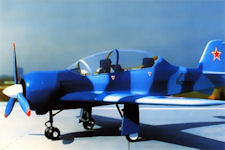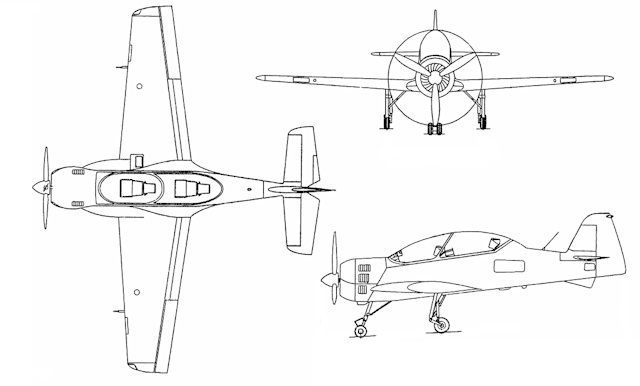Sukhoi Su-49 Training aircraft
 Sukhoi's Su-49 was selected by the Russian Air Force in December 2001 over the Yakovlev Yak-154 for initial flight training and to maintain frontline pilots' skills. Sukhoi proposed Novosibirsk aircraft production association (NAPO) - its sister company within the Sukhoi holding company - build the Su-49. By August 2002 Sukhoi was in the final stage of negotiations with the Russian defence ministry over an order for 300Su-49 trainers. The first development prototype was to fly by the end of 2003, with production aircraft deliveries to follow in 2004. The Defense Ministry also requested 1,000 Su-49s for the ROSTO Air Force support organisation, as an initial trainer for young pilots wishing to join the air force flying schools.
Sukhoi's Su-49 was selected by the Russian Air Force in December 2001 over the Yakovlev Yak-154 for initial flight training and to maintain frontline pilots' skills. Sukhoi proposed Novosibirsk aircraft production association (NAPO) - its sister company within the Sukhoi holding company - build the Su-49. By August 2002 Sukhoi was in the final stage of negotiations with the Russian defence ministry over an order for 300Su-49 trainers. The first development prototype was to fly by the end of 2003, with production aircraft deliveries to follow in 2004. The Defense Ministry also requested 1,000 Su-49s for the ROSTO Air Force support organisation, as an initial trainer for young pilots wishing to join the air force flying schools.
By October 2003 funding for the creation of training aircraft (UTS) of the Su-49 and Su-52 is currently almost frozen, which is why the implementation of the concept of the three-stage training of flight personnel approved by the Air Force Commander-in-Chief can be postponed indefinitely. "Currently, only the promising combat trainer Yak-130 is being carried out, and R&D funding for the creation of the Su-49 and Su-52 training aircraft has actually been suspended," a defense industrial complex source told Interfax-AVN on 21 October 2003.
He explained that the Su-49 training aircraft won the competition for the best piston-powered training aircraft in October 2001, and R&D financing for its creation since 2002 should be carried out through the state defense order. However, the allocated funds are not enough to lead the development of this aircraft. Under these conditions, Sukhoi Design Bureau is forced to actually suspend work on the Su-49 creation program. "Due to the fact that a competition for the best jet training aircraft has not yet been announced, work on the program for creating the Su-52 aircraft, which Sukhoi Design Bureau plans to submit to this competition, is slowly moving forward," the agency’s interlocutor said. According to the source, in the foreseeable future, the first two stages of the initial training of the air force’s flight personnel will be based on outdated material components - the Yak-52 and L-39 aircraft.
The entire cycle of flight training of Russian cadets was carried out on the L-39 for a 220-hour program. The introduction of initial flight training on piston-engine aircraft into the training program within 25% of the total flight will save $ 36,000 per pilot. The UTS Su-49 project was developed for this purpose, on the initiative of the joint-stock companies OKB Sukhoi and Advanced Technologies.
The machine is designed for both initial training and advanced flight training and to maintain the flight skills of pilots in military and civil aviation. The designed two modifications of the Su-49 differ only in the composition of the avionics (avionics). The initial training aircraft, designed to operate according to the rules of visual flights, is equipped, in particular, with an avionics complex with an OSB instrumental landing system and an automatic radio compass KDF 806, as well as standard direction indicators. The TCB will provide in-depth flight training on instruments with the basics of combat use and maintaining the flight skills of combatant pilots. The basis of the integrated avionics complex are multifunctional color liquid crystal indicators.
Su-49 was created on the basis of the well-known, mass-produced Su-26 and Su-29 aircraft. The aircraft has the best flight characteristics among piston training aircraft, and the cost of its flight hour is 2-2.5 times less than that of similar machines. The two-seat Su-49 was developed from the Su-29KS aerobatic aircraft. It has a 1,400kg (3,100lb) take-off weight and is fitted with a 420hp (315kW) Vedeneyev M-9F nine-cylinder radial piston engine. The airframe uses composite materials. The Su-49 cockpit is equipped with liquid-crystal head-down displays, a head-up display and Zvezda SKS-94M-49 ejection seats to simulate the cockpits of the Sukhoi Su-27/30. It is intended to provide navigation, night/all-weather, high-g and weapons instruction.
Excellent qualities of an airframe made of composite materials and designed for operational loads + 11 / -8 in combination with a powerful and economical engine with a capacity of 360 liters. from. allow you to teach flights, perform complex aerobatics, fly to a range of 1,500 km with a fuel consumption of 17 kg per 100 km of flight. In the cockpit, arranged in a tandem pattern, the front seat is for the student, the back is for the instructor. Each seat is equipped with a new SKS-94 emergency escape system, which has no analogues in the world. This system was developed for the Su-49 and Su-31 aircraft of Zvezda AOOT, which is known for creating the world's best K-36 ejection seat for combat aircraft.
The creators of the Su-49 spent a lot of money from the fund of the enterprise on the development of TCB. Sukhoi Design Bureau JSC is actually developing the project for the Su-49 training aircraft at its own expense, having spent on R&D an amount equivalent to about $ 5 million. However, the Air Force command did not have an opinion on the need for such a machine. It was hoped that the customer will still find time to deal with the concept proposed by the aviation industry and will support a program that would be beneficial in all respects for introducing piston-engined flight schools into practice.
The project of the Su-49 trainer is still unclaimed. Despite the victory in the competition for pilot projects of the UTS with a piston aircraft engine, the Air Force continued to refuse to the developer company guarantees of further purchases of Su-49 aircraft. Naturally, the developer does not want to risk $ 8.5 million for the development of a new machine without firm guarantees for the purchase of the Su-49 Air Force. In the near future, the Su-49 aircraft project itself will require "modernization" - for new design solutions, improved systems and equipment.
| Modification | Su-49 |
| Wing span, m | 9.19 |
| Aircraft length, m | 7.84 |
| Aircraft height, m | 2.89 |
| Wing area, m2 | 12.20 |
| Weight kg | |
| empty plane | 1050 |
| normal takeoff | 1340 |
| maximum take-off | 1500 |
| engine's type | 1 PD M-14P (M-14PF) |
| Horsepower | 1 x 360 (400) |
| Maximum speed, km / h | 350 |
| Practical range, km | 1500 |
| Rate of climb, m / min | 800 |
| Practical ceiling, m | 4000 |
| Max. operational overload | 9 - 11 |
| Crew | 2 |

|
NEWSLETTER
|
| Join the GlobalSecurity.org mailing list |
|
|
|

